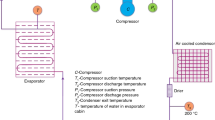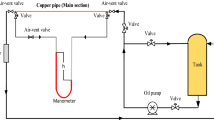Abstract
In recent years, the use of hybrid nanolubricants in cooling systems has become necessary due to their improved heat transfer properties. In this study, hybrid graphene oxide (GO)-doped tin oxide (SnO2) nanoparticles were synthesized by a simple chemical precipitation method to produce a nanolubricant. A mass fraction of 0.75% hybrid nanoparticles in polyol ester (POE) was used in the preparation of the nanolubricant. In the synthesis of hybrid nanoparticles, GO nanoparticles were doped with SnO2 at mass fraction of 1%, 2% and 3%. Single and hybrid nanolubricants were used to determine the performance values required for compressor operation. According to the results, when hybrid nanoparticles obtained by doping 2% doped GO nanoparticles were used, the power required for compressor operation decreased by 13.47% compared to pure POE. In addition, electromagnetic modeling of the single-phase auxiliary compressor motor was performed using finite element analysis software. For the hermetic reciprocating compressor, the electric current, power dissipation and magnetic field data were analyzed.















Similar content being viewed by others
Abbreviations
- m r :
-
Mass flow of refrigerant (kg/h)
- h 7 :
-
The enthalpy at the compressor inlet (kJ/kg)
- h 1 :
-
The enthalpy at the compressor outlet (kJ/kg)
- \(\dot{W}_{K}\) :
-
Compressor capacity (W)
- NL:
-
Nanolubricant
- B :
-
Flux density
- E :
-
Electric field
- J :
-
Current density
- Ρ :
-
Conductivity
- Ag:
-
Silver
- Al2O3 :
-
Alumina
- COP:
-
Coefficient of performance
- Cu:
-
Copper
- DIW:
-
Deionized water
- FEA:
-
(Finite element analysis)
- FESEM:
-
(Field emission scanning electron microscopy)
- FTIR:
-
Fourier transform infrared spectrophotometer
- GO:
-
Graphene oxide
- Gr:
-
Graphene
- H3PO4 :
-
Phosphoric acid
- HCI:
-
Hydrochloric acid
- KMnO4 :
-
Potassium permanganate
- PAG46:
-
Polyalkylene glycol
- POE:
-
Polyol ester
- SDBS:
-
Sodium dodecyl benzene sulfonate
- SiO2 :
-
Silicon oxide
- SnO2 :
-
Tin oxide
- TEM:
-
Transmission electron microscope
- TiO2 :
-
Titanium dioxide
- TX-100:
-
Triton X-100
- XRD:
-
X-ray diffraction
References
Çiftçi, E.: Pool boiling heat transfer properties of water-based dilute Fe+ ZnO hybrid nanofluid under low heat flux condition: a numerical study. gazi Üniversitesi Fen Bilimleri Dergisi Part C Tasarım ve Teknoloji 9(1), 84–94 (2021). https://doi.org/10.29109/gujsc.868777
Afshari, F.; Tuncer, A.D.; Sözen, A.; Variyenli, H.I.; Khanlari, A.; Gürbüz, E.Y.: A comprehensive survey on utilization of hybrid nanofluid in plate heat exchanger with various number of plates. Int. J. Numer. Methods Heat Fluid Flow (2021). https://doi.org/10.1108/HFF-11-2020-0743
Duangthongsuk, W.; Wongwises, S.: Heat transfer enhancement and pressure drop characteristics of TiO2–water nanofluid in a double-tube counter flow heat exchanger. Int. J. Heat Mass Transf. 52(7–8), 2059–2067 (2009). https://doi.org/10.1016/j.ijheatmasstransfer.2008.10.023
Tiwari, A.K.; Ghosh, P.; Sarkar, J.: Heat transfer and pressure drop characteristics of CeO2/water nanofluid in plate heat exchanger. Appl. Therm. Eng. 57(1–2), 24–32 (2013). https://doi.org/10.1016/j.applthermaleng.2013.03.047
Martin, K.; Sözen, A.; Çiftçi, E.; Ali, H.M.: An experimental investigation on aqueous Fe–CuO hybrid nanofluid usage in a plain heat pipe. Int. J. Thermophys. 41(9), 1–21 (2020). https://doi.org/10.1007/s10765-020-02716-6
Sözen, A.; Gürü, M.; Menlik, T.; Karakaya, U.; Çiftçi, E.: Experimental comparison of Triton X-100 and sodium dodecyl benzene sulfonate surfactants on thermal performance of TiO2—deionized water nanofluid in a thermosiphon. Exp Heat Transf 31(5), 450–469 (2018). https://doi.org/10.1080/08916152.2018.1445673
Akkaya, M.: MoO3 /PAG ve ZnO/PAG Nanoyağlayıcılarının Soğutma Sisteminin Performans Parametrelerine Etkilerinin Belirlenmesi. Bitlis Eren Üniversitesi Fen Bilimleri Dergisi 10(2), 521–532 (2021). https://doi.org/10.17798/bitlisfen.857657
Ghachem, K.; Aich, W.; Kolsi, L.: Computational analysis of hybrid nanofluid enhanced heat transfer in cross flow micro heat exchanger with rectangular wavy channels. Case Stud. Therm. Eng. 24, 100822 (2021). https://doi.org/10.1016/j.csite.2020.100822
Hashemi Karouei, S.H.; Ajarostaghi, S.S.M.; Gorji-Bandpy, M.; Hosseini Fard, S.R.: Laminar heat transfer and fluid flow of two various hybrid nanofluids in a helical double-pipe heat exchanger equipped with an innovative curved conical turbulator. J. Therm. Anal. Calorim. 143(2), 1455–1466 (2021). https://doi.org/10.1007/s10973-020-09425-0
Dezfulizadeh, A.; Aghaei, A.; Joshaghani, A.H.; Najafizadeh, M.M.: Exergy efficiency of a novel heat exchanger under MHD effects filled with water-based Cu–SiO2-MWCNT ternary hybrid nanofluid based on empirical data. J. Therm. Anal. Calorim. (2021). https://doi.org/10.1007/s10973-021-10867-3
Irandoost Shahrestani, M.; Houshfar, E.; Ashjaee, M.; Allahvirdizadeh, P.: Convective heat transfer and pumping power analysis of MWCNT+ Fe3O4/water hybrid nanofluid in a helical coiled heat exchanger with orthogonal rib turbulators. Front. Energy Res. 9, 12 (2021). https://doi.org/10.3389/fenrg.2021.630805
Soylu, S.K.; Atmaca, İ; Asiltürk, M.; Doğan, A.: Improving heat transfer performance of an automobile radiator using Cu and Ag doped TiO2 based nanofluids. Appl. Therm. Eng. 157, 113743 (2019). https://doi.org/10.1016/j.applthermaleng.2019.113743
Kiruba, R.; Jeevaraj, A.K.S.: Effect of temperature and concentration on the molecular interactions of Cu/ZnO-EG nanofluids using ultrasonic study. Integr. Ferroelectr. 150(1), 59–65 (2014). https://doi.org/10.1080/10584587.2014.873327
Babu, P.N.; Mohankumar, D.; Kumar, P.M.; Makeshkumar, M.; Gokulnath, M.; Gurubalaji, K.; Ashok, M.: Energy efficient refrigeration system with simultaneous heating and cooling. Today Proc. Mater. (2021). https://doi.org/10.1016/j.matpr.2021.03.072
Srinivas, M.N.; Padmanabhan, C.: Computationally efficient model for refrigeration compressor gas dynamics. Int. J. Refrig 25(8), 1083–1092 (2002). https://doi.org/10.1016/S0140-7007(01)00109-8
Akkaya, M.; Menlik, T.; Sözen, A.: Performance enhancement of a vapor compression cooling system: an application of POE/Al2O3. J. Polytech. 24(3), 755–761 (2021). https://doi.org/10.2339/politeknik.679563
Akkaya, M.; Menlik, T.; Sözen, A.; Gürü, M.: The effects of triton x–100 and tween 80 surfactants on the thermal performance of a nano-lubricant: an experimental study. Int. J. Precis. Eng. Manuf. Green Technol. 8(3), 955–967 (2021). https://doi.org/10.1007/s40684-020-00280-w
Akkaya, M.; Menlik, T.; Sözen, A.; Gürü, M.: Experimental investigation of nanolubricant usage in a cooling system at different nanoparticle concentrations. Heat Transf. Res. 51(10), 949–965 (2020). https://doi.org/10.1615/HeatTransRes.2020033812
Dey, P.; Mandal, B.K.: Performance enhancement of a shell-and-tube evaporator using Al2O3/R600a nanorefrigerant. Int. J. Heat Mass Transf. 170, 121015 (2021). https://doi.org/10.1016/j.ijheatmasstransfer.2021.121015
Chauhan, S.S.: Performance evaluation of ice plant operating on R134a blended with varied concentration of Al2O3/SiO2/PAG composite nanolubricant by experimental approach. Int. J. Refrig 113, 196–205 (2020). https://doi.org/10.1016/j.ijrefrig.2020.01.021
Farahani, S.D.; Farahani, M.; Ghanbari, D.: Experimental study of the effect of spiral-star fins and nano-oil-refrigerant mixture on refrigeration cycle characteristics. J. Therm. Anal. Calorim. (2021). https://doi.org/10.1007/s10973-021-10921-0
Berman, D.; Erdemir, A.; Sumant, A.V.: Graphene: a new emerging lubricant. Mater. Today 17(1), 31–42 (2014). https://doi.org/10.1016/j.mattod.2013.12.003
Yang, S.; Cui, X.; Zhou, Y.; Chen, C.: Study on the effect of graphene nanosheets refrigerant oil on domestic refrigerator performance. Int. J. Refrig. 110, 187–195 (2020). https://doi.org/10.1016/j.ijrefrig.2019.11.008
Rajkumar, P.; Diwakar, K.; Gnanamuthu, R.M.; Subadevi, R.; Sivakumar, M.: Investigations on partially reduced graphene oxide capped sulfur/polyaniline composite as positive electrode material for lithium-sulfur battery. Mater. Res. Express 6(9), 094005 (2019)
Raghavulu, K.V.; Rasu, N.G.: An experimental study on the improvement of coefficient of performance in vapor compression refrigeration system using graphene lubricant additives. Energy Sources Part A Recov. Utili. Environ. Eff. (2021). https://doi.org/10.1080/15567036.2021.1909186
Sanukrishna, S.S.; Prakash, M.J.: Exploiting the potentials of graphene nano-platelets for the development of energy-efficient lubricants for refrigeration systems. In: Green Buildings and Sustainable Engineering, pp. 303–312. Springer, Singapore (2020). https://doi.org/10.1007/978-981-15-1063-2_24
Babarinde, T.O.; Akinlabi, S.A.; Madyira, D.M.; Adedeji, P.A.; Ekundayo, F.M.: Improving the performance of LPG with graphene-nanolubricant in a domestic refrigerator: an artificial intelligence approach. Int. J. Ambient Energy (2021). https://doi.org/10.1080/01430750.2021.1914160ç
Karpe, M., Ghosh, S., Shindhe, N., Birajdar, R., Bhave, D.: Optimization of single-phase ınduction motor. In: 2019 IEEE Conference on Energy Conversion (CENCON), pp. 115–120. IEEE (2019). https://doi.org/10.1109/CENCON47160.2019.8974827
Balci, S.: Senkron generatörlerde farklı stator oluk yapılarının uç gerilimine etkisinin sonlu elemanlar yöntemi ile analizi. Bitlis Eren Üniversitesi Fen Bilimleri Dergisi 8(3), 947–957 (2019). https://doi.org/10.17798/bitlisfen.518348
Choudhari, M.S.; Chaurasiya, P.K.; Thakur, M.; Paswan, M.; Sharma, V.K.: Performance investigation of the hydrogen-based energy storage system employing high-pressure metal hydride pair. Energy Sources Part A Recov. Util. Environ. Eff. (2021). https://doi.org/10.1080/15567036.2021.2000070
Arockia Dhanraj, J.; Muthiya, S.J.; Subramaniam, M.; Salyan, S.: A comparative study with J48 and random tree classifier for predicting the state of hydraulic braking system through vibration signals. SAE Technical Paper, 28-0254 (2021)
Hummers, W.S., Jr.; Offeman, R.E.: Preparation of graphitic oxide. J. Am. Chem. Soc. 80(6), 1339–1339 (1958)
Zaaba, N.I.; Foo, K.L.; Hashim, U.; Tan, S.J.; Liu, W.W.; Voon, C.H.: Synthesis of graphene oxide using modified hummers method: solvent influence. Procedia Eng. 184, 469–477 (2017). https://doi.org/10.1016/j.proeng.2017.04.118
Ranjan, P.; Agrawal, S.; Sinha, A.; Rao, T.R.; Balakrishnan, J.; Thakur, A.D.: A low-cost non-explosive synthesis of graphene oxide for scalable applications. Sci. Rep. 8(1), 1–13 (2018). https://doi.org/10.1038/s41598-018-30613-4
Nugroho, A.; Bo, Z.; Mamat, R.; Azmi, W.H.; Najafi, G.; Khoirunnisa, F.: Extensive examination of sonication duration impact on stability of Al2O3-Polyol ester nanolubricant. Int. Commun. Heat Mass Transf. 126, 105418 (2021). https://doi.org/10.1016/j.icheatmasstransfer.2021.105418
Novikova, A.A.; Burlakova, V.E.; Varavka, V.N.; Uflyand, I.E.; Drogan, E.G.; Irkha, V.A.: Influence of glycerol dispersions of graphene oxide on the friction of rough steel surfaces. J. Mol. Liq. 284, 1–11 (2019). https://doi.org/10.1016/j.molliq.2019.03.111
Cengel, Y.A.; Boles, M.A.: Thermodynamics: An Engineering Approach 6th Edition (SI Units). The McGraw-Hill Companies, Inc., New York (2007)
Liu, J.; Li, Y.; Zhao, H.: A temperature measurement system based on pt100. In: 2010 International Conference on Electrical and Control Engineering, Wuhan (China), pp. 296–298 (2010). https://doi.org/10.1109/iCECE.2010.79
Kawahito, S.; Cerman, A.; Tadokoro, Y.: A digital fluxgate magnetic sensor interface using sigma-delta modulation for weak magnetic field measurement. In: IMTC/2002. Proceedings of the 19th IEEE Instrumentation and Measurement Technology Conference, Anchorage, AK, USA, pp. 257–260 (2002). https://doi.org/10.1109/IMTC.2002.1006849
Holman, J.P.: Experimental Methods for Engineers, p. 698. McGraw-Hill, Boston (2001)
Balci, S.: Evirici Çıkış Transformatörlerinin Modellenmesi ve Analizi. Yüksek Lisans Tezi, Gazi Üniversitesi Fen Bilimleri Enstitüsü, 53s., Ankara (2010)
Bastos, J.P.A., Sadowski, N.: Electromagnetic Modeling by Finite Element Methods. Universidade Federal de Santa Catarina Florianopolis, Brazil, Copyright by Marcel Dekker (2003)
Yamankaradeniz, R.; Horuz, İ; Coşkun, S.; Kaynaklı, Ö.; Yamankaradeniz, N.: 22-İklimlendirme Esasları ve Uygulamaları. Dora Yayıncılık (2012)
Ohunakin, O.S.; Adelekan, D.S.; Gill, J.; Atayero, A.A.; Atiba, O.E.; Okokpujie, I.P.; Abam, F.I.: Performance of a hydrocarbon driven domestic refrigerator based on varying concentration of SiO2 nano-lubricant. Int. J. Refrig. 94, 59–70 (2018). https://doi.org/10.1016/j.ijrefrig.2018.07.022
Harichandran, R.; Paulraj, P.; Raja, S.M.P.; Raman, J.K.: Effect of h-BN solid nanolubricant on the performance of R134a–polyolester oil-based vapour compression refrigeration system. J. Braz. Soc. Mech. Sci. Eng. 41(3), 1–11 (2019). https://doi.org/10.1007/s40430-019-1645-7
Kalluf, F.J.H.; Tutelea, L.N.; Boldea, I.; Espindola, A.: 2/4-POLE split-phase capacitor motor for small compressors: a comprehensive motor characterization. IEEE Trans. Ind. Appl. 50(1), 356–363 (2013). https://doi.org/10.1109/TIA.2013.2272913
Kim, Y.K.; Choi, M.C.; Suh, K.H.; Ji, Y.C.; Wang, D.S.: High-speed induction motor development for small centrifugal compressor. In: ICEMS'2001. Proceedings of the Fifth International Conference on Electrical Machines and Systems (IEEE Cat. No. 01EX501), vol. 2, pp. 891–894. IEEE (2001). https://doi.org/10.1109/ICEMS.2001.971821
Lesieutre, B.; Kosterev, D.; Undrill, J.: Phasor modeling approach for single phase A/C motors. In: 2008 IEEE Power and Energy Society General Meeting-Conversion and Delivery of Electrical Energy in the 21st Century, pp. 1–7. IEEE (2008). https://doi.org/10.1109/PES.2008.4596554
Acknowledgements
The author thanks the Karamanoğlu Mehmetbey University (Faculty of Engineering) for providing the facilities.
Author information
Authors and Affiliations
Corresponding author
Rights and permissions
About this article
Cite this article
Akkaya, M. Usage of Graphene-Doped Tin Oxide Hybrid Nanocomposites in Compressor and Electromagnetic Modeling for Single-Phase Compressor Motor. Arab J Sci Eng 48, 3097–3110 (2023). https://doi.org/10.1007/s13369-022-07116-6
Received:
Accepted:
Published:
Issue Date:
DOI: https://doi.org/10.1007/s13369-022-07116-6




